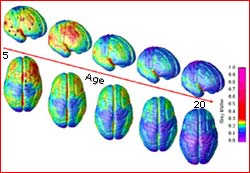Imaging study shows brain maturing

Time-Lapse Imaging Tracks Brain Maturation from ages 5 to 20 <br>Constructed from MRI scans of healthy children and teens, the time-lapse "movie" (http://www.nimh.nih.gov/press/prbrainmaturing.mpeg), from which the above images were extracted, compresses 15 years of brain development (ages 5 - 20) into just a few seconds. Red indicates more gray matter, blue less gray matter. Gray matter wanes in a back-to-front wave as the brain matures and neural connections are pruned. Areas performing more basic functions mature earlier; areas for higher order functions mature later. The prefrontal cortex, which handles reasoning and other "executive" functions, emerged late in evolution and is among the last to mature. Studies in twins are showing that development of such late-maturing areas is less influenced by heredity than areas that mature earlier. <br> <br>Source: Paul Thompson, Ph.D. <br>UCLA Laboratory of Neuroimaging
The brain’s center of reasoning and problem solving is among the last to mature, a new study graphically reveals. The decade-long magnetic resonance imaging (MRI) study of normal brain development, from ages 4 to 21, by researchers at NIH’s National Institute of Mental Health (NIMH) and University of California Los Angeles (UCLA) shows that such “higher-order” brain centers, such as the prefrontal cortex, don’t fully develop until young adulthood.
A time-lapse 3-D movie that compresses 15 years of human brain maturation, ages 5 to 20, into seconds shows gray matter – the working tissue of the brain’s cortex – diminishing in a back-to-front wave, likely reflecting the pruning of unused neuronal connections during the teen years. Cortex areas can be seen maturing at ages in which relevant cognitive and functional developmental milestones occur. The sequence of maturation also roughly parallels the evolution of the mammalian brain, suggest Drs. Nitin Gogtay, Judith Rapoport, NIMH, and Paul Thompson, Arthur Toga, UCLA, and colleagues, whose study is published online during the week of May 17, 2004 in The Proceedings of the National Academy of Sciences.
“To interpret brain changes we were seeing in neurodevelopmental disorders like schizophrenia, we needed a better picture of how the brain normally develops,” explained Rapoport.
The researchers scanned the same 13 healthy children and teens every two years as they grew up, for 10 years. After co-registering the scans with each other, using an intricate set brain anatomical landmarks, they visualized the ebb and flow of gray matter – neurons and their branch-like extensions – in maps that, together, form the movie showing brain maturation from ages 5 to 20.
It was long believed that a spurt of overproduction of gray matter during the first 18 months of life was followed by a steady decline as unused circuitry is discarded. Then, in the late l990s, NIMH’s Dr. Jay Giedd, a co-author of the current study, and colleagues, discovered a second wave of overproduction of gray matter just prior to puberty, followed by a second bout of “use-it-or-lose-it” pruning during the teen years.
The new study found that the first areas to mature (e.g., extreme front and back of the brain) are those with the most basic functions, such as processing the senses and movement. Areas involved in spatial orientation and language (parietal lobes) follow. Areas with more advanced functions — integrating information from the senses, reasoning and other “executive” functions (prefrontal cortex) – mature last.
In a related study published a few years ago, Rapoport and colleagues discovered an exaggerated wave of gray matter loss in teens with early onset schizophrenia. These teens, who became psychotic prior to puberty, lost four times the normal amount of gray matter in their frontal lobes, suggesting that childhood onset schizophrenia “may be an exaggeration of a normal maturation process, perhaps related to excessive synaptic pruning,” note the researchers. By contrast, children with autism show an abnormal back-to-front wave of gray matter increases, rather than decreases, suggesting “a specific faulty step in early development.”
Also participating in the new study were: Leslie Lusk, Cathy Vaituzis, Tom Nugent, David Herman, Drs. Deanna Greenstein, Liv Clasen, NIMH; Kiralee Hayashi, UCLA.
NIMH is part of the National Institutes of Health (NIH), the Federal Government’s primary agency for biomedical and behavioral research. NIH is a component of the U.S. Department of Health and Human Services.
Media Contact
All latest news from the category: Health and Medicine
This subject area encompasses research and studies in the field of human medicine.
Among the wide-ranging list of topics covered here are anesthesiology, anatomy, surgery, human genetics, hygiene and environmental medicine, internal medicine, neurology, pharmacology, physiology, urology and dental medicine.
Newest articles

Scientists transform blood into regenerative materials
… paving the way for personalized, blood-based, 3D-printed implants. Scientists have created a new ‘biocooperative’ material based on blood, which has shown to successfully repair bones, paving the way for…

A new experimental infection model in flies
…offers a fast and cost-effective way to test drugs. Researchers at the Germans Trias i Pujol Research Institute and Hospital have reinforced their leading role in infectious disease research by…

Material developed with novel stretching properties
KIT researchers produce metamaterial with different extension and compression properties than conventional materials. With this material, the working group headed by Professor Martin Wegener at KIT’s Institute of Applied Physics…



